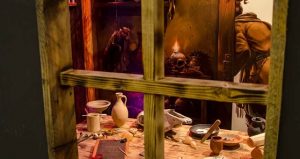3 December 2016 – 31 December 2017
“There is no one, too, who does not dread being spell-bound by means of evil imprecations”, wrote Pliny the Elder almost two thousand years ago. That the Romans were not free from evil spells in Pannonia either is clear from three engraved lead curse tablets found recently around Roman graves in Óbuda.
From 3 December 2016, the exhibition at the Aquincum Museum presents a special and forbidden part of Roman magic – malefic spells – and the magical amulets and other tools people used to protect themselves from evil forces.
Curse tablets, like the three lead tablets from Aquincum exhibited now for the first time, were essential tools of destructive magic. These could be used to communicate with the gods and the forces of the underworld and to ask their help to exact satisfaction for injuries and wrongs, or to crush the will of another person. All segments of Roman society – from the imperial family to slaves – could make use of dark magic, if they felt they had no other options left.
The curse texts were written usually by sorcerers steeped in secret knowledge, likely following the instructions of magical handbooks. The tablets were often hidden near temples or other places – e.g. cemeteries or lakes – thought to have a connection with the afterlife. Making and commissioning curses was considered to be a serious crime, punishable even by death according to Roman law.
There were also numerous magical protections against natural or supernatural threats in the Roman period. The exhibition also presents these in detail, including jewellery made from gold, bronze, bones, stone and amber as well as small capsules for holding amulets into which metal sheets or pieces of papyri with magical signs and mysterious formulae were placed.
The exhibition includes a reconstructed workshop of a Roman sorcerer, complete with the full toolkit: mysterious materials, magical devices and collection of spells.
The exhibition also features illustrations by one of the most famous Hungarian cartoonists, Dávid Cserkuti. The illustrations tell the story of a partly imaginary conflict based on one of the Aquincum curse tablets. According to the text a group of free men and slaves had a sorcerer write a curse on a lead tablet ahead of a court case at the turn of the 2nd and 3rd centuries, to silence and incapacitate their enemies.
Supported by Graphisoft Park
Click here to view the exhibition catalogue.
Curator: Gábor Lassányi



